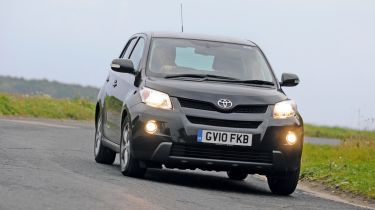Toyota Urban Cruiser 1.33
Toyota's crossover effort is the least striking of our assembled quartet, but does the economical engine and and build quality make up for the high asking price?
Toyota has a strong track record of niche models. From rugged off-roaders to hi-tech hybrids, it’s always tried to squeeze a car into every sector. Therefore it’s no surprise the firm jumped on the crossover bandwagon with its Urban Cruiser. The tough-looking car made its UK debut in 2009.
It uses the tried-and-tested Yaris supermini platform, and aims to combine streetwise looks with low running costs. Flared wheelarches, a bold nose and a slightly raised ride height all help the Urban Cruiser stand out from conventional models. However, it can’t match the Juke or Soul for kerbside appeal.
It’s a similar story inside, where the Toyota feels like a conventional supermini. There’s a distinctive dashboard and quirky dials, but the rest of the cabin looks a little bland. It also feels cramped compared to rivals, although a totally flat rear floor and sliding bench boost legroom for passengers. However, boot capacity is reduced to 314 litres when you push the seats all the way back. At least the interior is solidly screwed together, while the kit list wouldn’t look out of place in an executive saloon. A Bluetooth phone connection, climate control and keyless entry are all standard.
In terms of performance, the Toyota struggles to keep up with its rivals. The 100bhp 1.33-litre engine is smooth and keen to rev, but the Urban Cruiser’s 0-60mph sprint of 13 seconds is a full two seconds slower than the Juke’s. It’s not all bad news, though, because a standard six-speed gearbox helps make it a reasonably refined motorway companion.
Head down a twisty back road and the Cruiser’s squat stance and wheel-at-each-corner layout result in safe and predictable handling. However, the steering, throttle and clutch pedals lack feedback.
The Toyota is at its best in built-up areas, where its light controls, compact dimensions and decent visibility make light work of crowded city streets. Adding to the car’s urban appeal is a smooth and fast-acting stop-start system.
This piece of kit also helped the Urban Cruiser deliver 37.2mpg at the pumps – that’s 6.5mpg better than the Nissan. And with emissions of 129g/km, the Toyota should be the cheapest of our quartet to run, although the savings need to offset the hefty £15,418 price tag.
Only the bigger and faster Skoda is more expensive. Against such talented opposition, the Urban Cruiser’s price premium is difficult to justify, even when you take into account Toyota’s recently introduced five-year warranty.
Details
Chart position: 4
WHY: It’s pricey, but smaller engine offers as much performance as the others, and is greener, too.







